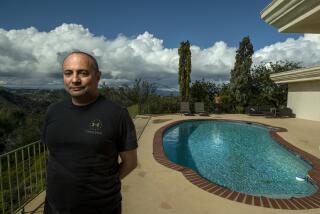Russian Official Had Dual Role in Uranium Pact
WASHINGTON — Two years ago, a small Pennsylvania consulting firm was quietly hired by another American company responsible for carrying out a sensitive nuclear security agreement between the United States and Russia.
As it turns out, one of the Pennsylvania firm’s owners was Yevgeny O. Adamov, who then also headed the Russian Ministry of Atomic Energy. At the time, Adamov’s ministry was overseeing multimillion-dollar negotiations between Russia and USEC Inc., the same company that hired the Pennsylvania firm.
These circumstances have raised new questions about the U.S. government’s decision to hand a momentous national security function to private industry.
USEC buys bomb-grade uranium stripped from Russian warheads as the exclusive agent for the U.S. government under a novel, post-Cold War agreement known as Megatons to Megawatts. The uranium is shipped to the United States, where it is resold as fuel for nuclear power plants.
The urgency of removing weapon-grade uranium from circulation in Russia has been underscored since the Sept. 11 attacks on the World Trade Center and the Pentagon. President Bush and other leaders have warned that terrorists, including Osama bin Laden, are intent on obtaining nuclear and other weapons of mass destruction.
Adamov’s Involvement Unknown, Officials Say
USEC executives say they did not know who owned the consulting firm, and did not learn of Adamov’s involvement until he resigned his government post last year amid allegations of corruption.
They said the firm was hired for legitimate consulting work to identify prospective joint ventures between USEC and the commercial arm of the Russian atomic energy ministry. No projects were launched before the contract expired.
Peter R. Orszag, a Brookings Institution economist and critic of privatizing the nuclear security agreement, said the consulting deal involving the Pennsylvania firm reflects badly on USEC’s management.
“I find it inconceivable that the United States government would sign a consulting contract with a firm owned by the [Russian] minister of atomic energy,” Orszag said. “Most private sector entities would not undertake such a transaction.”
Federal law discourages companies from making private business arrangements with public officials in foreign governments. The U.S. Foreign Corrupt Practices Act makes it a crime for a U.S. business to make payments to a government official that could be construed as an inducement.
A USEC spokesman said the company did not violate the law, and he noted that the contract called for the consulting firm, Omeka Ltd., to comply with all applicable Russian and U.S. laws, including the Foreign Corrupt Practices Act.
Interviews and records reviewed by The Times show that USEC paid Omeka $123,880 for consulting fees and expenses incurred from Jan. 1, 2000, to March 31, 2001. At the same time--under terms specified in its contract with USEC--Omeka also received payments totaling $90,000 or more from the commercial arm of Adamov’s government ministry.
The contract ended around the time Adamov resigned from the Russian government in March 2001. Earlier that year, an investigative report circulated by a panel of Russia’s lower house of parliament, or Duma, alleged that Adamov had mixed his private business dealings and public responsibilities. At the time, Adamov denied any wrongdoing.
Company Official Tells of Blind Trust
The report noted Adamov’s ownership in Omeka; The Times could not confirm other allegations contained in the document. The report did not refer to Omeka’s contract with USEC.
Adamov declined to respond to requests for an interview for this article or to answer written questions submitted to him in Russia. An Omeka executive said he did not believe Adamov received revenue from Omeka while he was a government minister.
“We more or less put it [Adamov’s ownership] in a blind trust,” said Mark M. Kaushansky, who co-founded Omeka in 1994 with Adamov.
Now based in Bethesda, Md., USEC once was a government-owned corporation, like Amtrak, and it processed the nation’s uranium for use in nuclear power plants. As such, USEC had responsibility for carrying out the Megatons to Megawatts pact with Russia. The 1993 agreement calls for 500 metric tons of weapon-grade uranium to be stripped from the Russian warheads, blended to a lower level of radioactivity and sold to the U.S.
When the federal government sold USEC to investors for $1.9 billion in 1998, the privatized entity retained responsibility for the national security agreement between the U.S. and Russia.
The agreement calls for the publicly traded company to purchase a certain amount of uranium each year from the Russians. But it is up to USEC to negotiate the price for the uranium, which it resells to utilities in the U.S.
Analysts estimate that the Russians, over a 20-year period ending in 2013, would be paid approximately $12 billion for the uranium under the Megatons to Megawatts accord. The exact price, however, has been subject to recurrent negotiations between the Russians and USEC.
Indeed, the financial terms have been contested intensely; even a slight shift in price can be worth huge sums to the Russian government or USEC.
Both sides now are trying to reach an agreement for new pricing terms, through 2013. The negotiations got underway in early 2000--about the same time that USEC retained Omeka.
The discussions that led to the consulting contract between USEC and Omeka began in late 1999. In a series of interviews for this article, USEC executives and a representative of Adamov’s company said the dealings had no connection with the negotiations regarding the national security agreement between the U.S. and Russian governments.
A USEC senior vice president, Philip G. Sewell, said Omeka was retained to provide “a speculative assessment” of opportunities with the commercial arm of the Russian atomic energy ministry, known as Tenex.
The contract specified that services were to be performed by “no one other than” Kaushansky, a Pittsburgh-based representative of Omeka who is Adamov’s business partner and whose title is general manager. Noting that Omeka is privately held, Kaushansky declined to quantify Adamov’s ownership, other than to say, “Yes, he had an equity stake in the company. . . . He is one of the owners.”
USEC executives said they hired Omeka to gain the consulting services of Kaushansky, a nuclear engineer and Russian immigrant who speaks English and Russian fluently. Until the report of the Duma’s Anti-Corruption Committee began circulating, they said they had no idea of Adamov’s involvement with Omeka.
No Attempt to Identify Ownership of Firm
Charles B. Yulish, a USEC spokesman and vice president, acknowledged that the company did not attempt to identify the ownership of Omeka before hiring the firm. Yulish said this was consistent with standard practices at USEC.
Upon learning of Adamov’s involvement with Omeka, the USEC executives said they had an in-house auditor review the contract and Kaushansky’s performance. The audit, they said, upheld the propriety of the arrangements.
“There’s nothing on its face or there’s nothing behind the face that warrants looking at it askance, in terms of whether monies were paid for favors or for work that wasn’t performed,” Yulish said.
The hiring of Omeka was handled by Sewell, who was and remains USEC’s chief negotiator with Adamov’s former ministry on the national security agreement.
Sewell said officials from Tenex were the first to recommend Kaushansky’s services, and that he relied on their word that Omeka was a bona fide entity.
Kaushansky told The Times that Tenex hired Omeka at some point before the company’s contract with USEC. Sewell said he was surprised when he learned, through the Duma report that began circulating in early 2001, about Adamov’s ownership stake in Omeka.
Should Kaushansky have disclosed Adamov’s role to USEC?
“I wish he had,” Sewell said. Company spokesman Yulish said USEC would not comment regarding whether it would have hired Omeka if the executives had known of Adamov’s role.
Yet Adamov’s involvement with Omeka was less than a secret:
On March 26, 1999, Energy Daily, a well-known industry publication in the U.S., reported that Adamov, his wife and Kaushansky had founded Omeka in the Pittsburgh suburb of Monroeville. In April 1999, this report was cited in the Moscow Times, an English-language daily.
Yulish said that USEC subscribed to Energy Daily. But he said the article, headlined “Russian Atomic Minister is Card-Carrying U.S. Capitalist,” was not included in the daily summary of news clippings that USEC distributed among its employees.
Yulish, Sewell and USEC’s general counsel, Robert J. Moore, said the national security agreement between the U.S. and Russia encourages USEC to pursue joint ventures with the Russians.
Kaushansky, while acknowledging Adamov’s ownership in Omeka, said his partner ceased any operational role upon becoming atomic energy minister in 1998. “He had no control over it,” said Kaushansky, who spoke with The Times by phone and at an office building in downtown Pittsburgh. Kaushansky said that he doubted that Adamov had been aware of Omeka’s contract with USEC.
Official Was in Position to Influence Talks
This much is not in dispute: Adamov and his subordinates were positioned to influence the outcome of the Russians’ negotiations with USEC regarding the Megatons to Megawatts accord.
And in May 2000--less than five months after hiring Adamov’s firm--representatives of USEC say the Russians tentatively agreed to new financial terms that were advantageous to USEC. However, the terms were not ratified by both governments before Adamov left his ministry post. They remain unresolved to this day, although USEC and Tenex recently submitted new pricing terms to both governments. The new terms are also considered beneficial to USEC.
*
Times staff writer Carol J. Williams in Moscow and researcher Janet Lundblad in Los Angeles contributed to this report.
More to Read
Sign up for Essential California
The most important California stories and recommendations in your inbox every morning.
You may occasionally receive promotional content from the Los Angeles Times.











